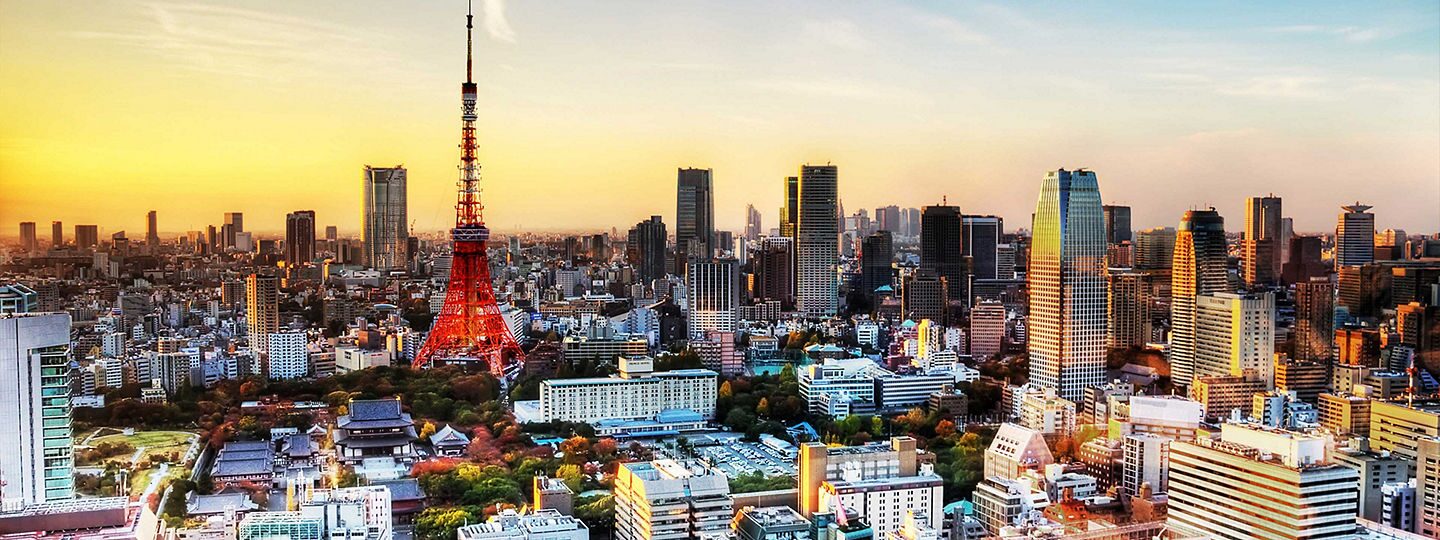Japan might not be a large country, but it packs a lot of incredible beauty within its coastal borders. Japan is an archipelago home to a main island plus a number of smaller islands.
On these islands are a vast array of magnificent natural wonders and manmade marvels.
See towering mountain and volcano peaks, feel the soft petals of a cherry blossom, listen to the chop of a knife as sushi and other Japanese delicacies are being prepared, and wander around historic temples.
The best places to visit in Japan are located all over the country and its many islands, from remote temple complexes to cosmopolitan cities. Here are some of the top places you don’t want to miss, all of which can be visited on a cruise vacation.

Tokyo: Japan’s Iconic City
Tokyo, Japan’s bustling capital city, is a wonder to the senses. Gleaming skyscrapers, an energetic nightlife, and some of the best cuisine in the world make it one of the best places to visit in Japan.
During a Tokyo port of call, you can see a wealth of tourist attractions as well as experience the day to day lifestyle of the city.
Top things to do in Tokyo include seeing the Imperial Palace, which serves as the primary residence of the emperor of Japan; making your way up to the top of the 1,092 Tokyo Tower for panoramic views; dining on some fresh seafood, or taking a shore excursion to the incredible Mount Fuji, which hovers impressively in the distance.
Many of our Japan itineraries also begin or end in the Tokyo cruise port of Yokohama, which is located less than 25 miles from Tokyo’s city center.
Ending your cruise in Yokohama provides you with the perfect opportunity to explore more of Tokyo. Extend your trip a few days and spend time exploring the city’s top sights with breaks to dine at delicious eateries for lunch and dinner before heading out to experience Tokyo’s nightlife.
While the big city lights of Japan are a big draw for travelers, the country is much more than just world-class cities. There are many places to visit in Japan that are perfect for nature lovers or history buffs.

Visit Kobe for Delectable Cuisine, Stunning Views, & Fascinating Temples
You may recognize the city’s name due to Kobe beef, a sought-after cut of Wagyu beef. The city of Kobe is in fact related to this cuisine due to its location near the Hyōgo Prefecture, where a particular strain of Japanese Black cattle are raised under the strict standards that are applied to Kobe beef. Eat it alongside a serving of Kobe’s famous sake, a type of rice wine, or visit one of the sake breweries in Kobe before or after your meal.
The city of Kobe is more than just its food and drink. Nature lovers will appreciate its scenic harborfront and the awe-inspiring Mount Rokko.
One of the best ways to experience these views is via the Maiko Marine Promenade on the Akashi Kaikyo Bridge, the tallest of its kind in Japan. Marvel at the surrounding mountain views while you stroll on top of glass floors, where you can see the rippling water beneath you.
Another way to get into nature and enjoy unforgettable city views is to climb to the top of Mount Rokko either by foot or cable car. From the lookout point, you can see the rooftops of the city far below and get a panoramic view of Osaka Bay.
From Kobe, you can also do a shore excursion to Nara, where you’ll find an important Buddhist temple complex called Todai-ji, which was once part of the Seven Great Temples.

See the Temples & Shrines of Kyoto
Kyoto boasts a vibrant city lifestyle and sprawling skyline punctuated by the Kyoto Tower that will impress any urban explorer. However, it’s the many temples and shrines all around the city that keep people wanting to cruise to Kyoto each season.
A can’t-miss site in Kyoto is the Fushimi Inari-taisha Shrine, characterized by its bright vermillion tunnels created from thousands of the traditional Japanese gates referred to as torii gates. On the other side of these tunnels is a hillside dotted with numerous shrines connected by a series of trails.
Kinkakuji Temple, a three-story temple wrapped in gold leaf, overlooks a lake so calm that it gives the temple a breathtakingly beautiful mirror image. Kiyomizu-dera Temple, a gleaming red hilltop temple and UNESCO World Heritage Site, is surrounded by cherry blossoms and is a beautiful spot for pictures.

Mount Fuji: Japan’s Tallest Peak
In a country full of volcanic peaks, Mount Fuji is the highest. Japan’s famous mountain is a must-see for many visitors due to its massive height of 12,380 feet. The volcano also serves as a defining symbol of Japan.
Mount Fuji is important to the country and has been regarded as a sacred site for centuries. Many people who climb the mountain to its summit consider it a sacred journey, particularly those who practice the Shinto faith. Many Shinto shrines are located at the base of Mount Fuji and along its side, which are visible as hikers make the journey up the mountainside.
On a cruise to Mt. Fuji, you’ll dock at the port of Shimizu. From there, it’s easy to take shore excursions to scenic viewpoints overlooking the mountain or to the Mount Fuji World Heritage Center, where you can learn more about the cultural and geographical significance of the volcano.

Kochi and Kagoshima: Southern Island Charm in Japan
Below the southern coastline of Japan’s mainland are the prefectures of Kochi and Kagoshima, located respectively on Shikoku Island and Kyushi island. During a cruise you can visit the capital cities of these prefectures, which are called by the same name.
These southern island ports of call are incredible to explore for a combination of island city life and nature.
Kochi is home to beaches, rugged capes, and a beautiful harbor. While there, you can visit Ryugado Caves, limestone caverns known for their immense size and believed to be over 150,000,000 years old. Kagoshima is also a great place to check out a sake brewery.
Kagoshima is known for the active volcano in its midst and surrounded by lava fields. Popular excursions to do while in port are both nature and history based. Visit the Ibusuki Sand Baths for a unique experience where you can bury your body in sand that is heated by underground hot springs before rinsing off in an actual hot spring; this ritual is said to have healing benefits. You can also spend the day in Kagoshima walking around the Chiran Peace Museum, learning more about Kamikaze pilots who departed from the Chiran airbase during World War II.

Hiroshima: A Beautiful City with a Tragic Past
Hiroshima has much to offer the modern traveler, like interesting museums, delectable cuisine, great shopping, and walkable gardens and parks. However, it’s the city’s past that weighs heavily on the minds of travelers who cruise to Hiroshima. During World War II, Hiroshima was decimated by an atomic bomb which resulted in a staggering loss of lives. It was also the precipice that marked the beginning of the end of World War II.
Sites throughout the city commemorate this tragic event, like the Peace Memorial Park, where you’ll find monuments, exhibits, and the remains of one of the only buildings that was still standing after the bomb dropped.
However, Hiroshima is much more than its past. Visit Hiroshima Castle to see how far the city has come in the past decades as it has rebuilt itself. The original Hiroshima Castle was destroyed by the atomic bomb blast, but the new one has been beautifully built with lovely grounds to walk around.
Experience Hiroshima’s food scene and sample the Okonomiyaki dish, a savory pancake that can be made with a variety of ingredients like seafood, pasta, or pork. Visit the Wood Egg Okonomiyaki Museum, where you’ll learn more about this traditional dish and can even try to make it yourself.
Another one of the best places to visit in Japan is the Itsukushima Shrine, also commonly referred to as Miyajima. This important shrine is located on a small sacred island across the bay from Hiroshima and is a World Heritage Site. Itsukushima Shrine is an often-photographed part of Japan due to the gate at its entrance, which seems to float on top of the water.

Aomori: An Off-the-Beaten-Path City With Cherry Blossoms Galore
Up on the northern tip of the mainland is Aomori, a less-visited city in Japan that will delight visitors with its laid-back vibe, museums, and outdoor activities. The city is known for its cherry blossom trees, and if you cruise to Aomori in the spring or summer, you might get to experience a local cherry blossom festival.
Hirosaki Park is one of the best places to see cherry blossoms in bloom. It is home to 2,600 cherry blossom trees as well as traditional Japanese architecture and scenic water features. Between April 23 and May 5, one of the most popular cherry blossom tree festivals occurs in this park, during which you can see a moat dyed pink and walk through a mystical cherry blossom tunnel.
Beyond nature, Aomori has a thriving cultural scene largely characterized by its many museums. Choose the museums easiest to get to via shore excursion or public transportation so you have extra time to wander its exhibits.
One of Aomori’s most well-known museums is Nebuta Museum WA-RASSE due to its eclectic and stunning art. Learn about the art form called Nebuta, which uses wire and paper to make 3-dimensional artwork. You’ll see massive displays that were created for past Aomori Nebuta Festivals. This museum will give you additional insight into the culture of Aomori, of which art is a big focal point.

Hakodate: Architecture and Mountain Views on Japan’s Northernmost Island
Hakodate is located on the northernmost island of Hokkaido and is a prominent city of the region. Many visitors are enthralled by the mountain of the same name while touring the city. Mount Hakodate creates a stunningly snowpeaked horizon, and its summit can be reached via an aerial ropeway gondola ride.

Book Your Cruise to Japan
Explore the best places to visit in the country on cruises to Japan that stop in these captivating ports. You can sail around Japan or choose a cruise that also stops in China and Taiwan. You can even include North America in your itinerary on a transpacific cruise. Browse our Japan itineraries and then call one of our cruise experts to help you book your stateroom or suite. Soon you’ll be sailing all around this remarkably picturesque and historical country.
This article is compliments of Celebrity Cruise Lines.
Lynn Sullivan
TRAVEL with EASe
(239) 337-3273
http://www.travelwithease.com
Lynn@travelwithease.com


 That smaller scale translates to all areas of the river cruise. You dine on a regular schedule at tables with other passengers (wine is included in the price of the cruise). Instead of 50 different things to do on board, amenities tend to be more modest with river cruises — think libraries, a workout room, cultural programs, and free Wifi vs. ten kids’ playrooms, glitzy Broadway shows, and a skydiving simulator. There tend to be fewer kids on river cruises, making them popular for couples seeking quiet and relaxed time together.
That smaller scale translates to all areas of the river cruise. You dine on a regular schedule at tables with other passengers (wine is included in the price of the cruise). Instead of 50 different things to do on board, amenities tend to be more modest with river cruises — think libraries, a workout room, cultural programs, and free Wifi vs. ten kids’ playrooms, glitzy Broadway shows, and a skydiving simulator. There tend to be fewer kids on river cruises, making them popular for couples seeking quiet and relaxed time together. Because of their larger size, ocean cruises offer plenty of options for many ages, from young kids to octogenarians, and they are often more able to accommodate a wide variety of special health needs. For this reason, they tend to make the best option for multi-generational family gatherings that include young children. For the traveler who is into high-octane adventure, ocean cruises provide a wide variety of activities on board, as well as exotic and more daring day excursions.
Because of their larger size, ocean cruises offer plenty of options for many ages, from young kids to octogenarians, and they are often more able to accommodate a wide variety of special health needs. For this reason, they tend to make the best option for multi-generational family gatherings that include young children. For the traveler who is into high-octane adventure, ocean cruises provide a wide variety of activities on board, as well as exotic and more daring day excursions. Lynn Sullivan
Lynn Sullivan
%5B40288%5D.png) of Alaska with transportation being done either by motorcoach or train. You will be on the go from early morning until evening. You don’t want to end your tour and then head home because you will be tired. Do the tour then get on the ship and relax and enjoy the rest Alaska has for you.
of Alaska with transportation being done either by motorcoach or train. You will be on the go from early morning until evening. You don’t want to end your tour and then head home because you will be tired. Do the tour then get on the ship and relax and enjoy the rest Alaska has for you. When you are booking your cruise, it is important to know which side of the ship you want to be on. I always recommend that you book your cabin on the land side. There will be announcements about wildlife sightings that you can look out and see while in your cabin. For me, I love having a balcony and in Alaska, it is even more fun. When you pull into some ports, you can sit on your balcony and watch people, wildlife and even planes taking off. It is also nice to sit on your balcony and have breakfast in the morning or just coffee. Plus, at night if you want to have a drink before dinner, sitting out and watching the sun go down (it never gets real dark though) is relaxing. If you have a suite, you can arrange to have dinner on your balcony as well. When we were cruising the Inside Passage, a boat came up and cruised with us with a guy playing the saxophone. It was nice sitting on the balcony and listening to music and watching the world as we cruised onward.
When you are booking your cruise, it is important to know which side of the ship you want to be on. I always recommend that you book your cabin on the land side. There will be announcements about wildlife sightings that you can look out and see while in your cabin. For me, I love having a balcony and in Alaska, it is even more fun. When you pull into some ports, you can sit on your balcony and watch people, wildlife and even planes taking off. It is also nice to sit on your balcony and have breakfast in the morning or just coffee. Plus, at night if you want to have a drink before dinner, sitting out and watching the sun go down (it never gets real dark though) is relaxing. If you have a suite, you can arrange to have dinner on your balcony as well. When we were cruising the Inside Passage, a boat came up and cruised with us with a guy playing the saxophone. It was nice sitting on the balcony and listening to music and watching the world as we cruised onward.%5B40287%5D.png)










































